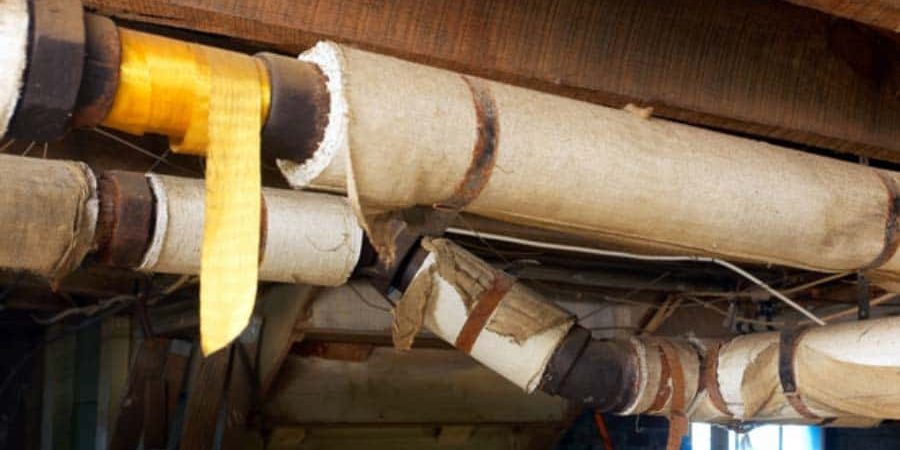Asbestos, is still a relevant hazard in today’s society. Its presence has been a significant part of the infrastructure of countries for centuries. In this post, you’ll learn about the origins of the material, its first and last uses, and the precautions that were set in place to protect people from it.
1. Ancient Usage of Asbestos
Inhabitants of a region in East Finland used asbestos to reinforce pots and cooking utensils as far back as 4,500 years ago. The term ‘Asbestos’ originates from the Greek word “ἄσβεστος,” which means ‘inextinguishable’ or ‘indestructible’. The Greeks noticed its fire-resistant properties and utilised it for clothing, tablecloths and candlewicks. Some historians even suggest that asbestos clothing would have been thrown into fire to clean it, as the material would remain unchanged.
Ancient Egyptians incorporated asbestos into the mummification cloth, burying Pharaohs in it to shield their bodies from decay. They believed the fireproof properties came from the hair and fur of a fire-resistant lynx. A use for asbestos, such as this, would benefit our society greatly, only if there were no harmful drawbacks!
2. Early Health Effects of Asbestos
Given its widespread use, the health impacts of asbestos in different societies soon became evident. In the Roman Empire, Pliny the Elder, a roman naturalist noted the sickness in the lungs of slaves who wove asbestos into cloth. This is believed to be one of the earliest records of health issues related to asbestos exposure. The observation of lung diseases in asbestos workers, even from ancient times, foreshadowed the health crisis that the modern world would face many centuries later.
As the use of asbestos increased during the industrial revolution, health effects began to be more noticeable among workers. By the late 19th and early 20th centuries, reports emerged of lung problems among asbestos factory workers were reported. The term ‘Asbestosis’ was first coined in the 1920s. Initially, doctors coined the term to describe the condition where inhaled asbestos fibers scarred the lung tissue, leading to symptoms like shortness of breath and coughing. Subsequently, they diagnosed workers exposed to large amounts of the material over long durations with asbestosis.
As time progressed, researchers gathered more data on how asbestos affected the lungs. Consequently, this data began to reveal a link between Asbestosis and Mesothelioma, a rare form of cancer that lines the lungs and chest cavity.
3. Asbestos in the UK
Asbestos played a large role in impacting certain areas of our society. The material was at its peak usage between 1950s and 1980s in the UK due to its insulating properties. Contractors primarily used it for roofing, insulation, and floor tiles. Places like Clydebank in Scotland, which had a strong shipbuilding industry, used vast amounts of asbestos for insulation on ships. Many buildings built before 1980s in the UK contain asbestos, and this doesn’t just include houses. Contractors used asbestos to construct many public buildings, including schools.
The UK’s extensive asbestos use led to one of the world’s highest mesothelioma rates. With the disease remaining dormant for decades, many exposed in the 1980s are only being diagnosed recently. This shows an impact on our society nearly 30 years after it was made illegal.
If you want to determine whether your home or workplace contains asbestos materials, check the links below for more information.
Management Surveys: We conduct comprehensive management surveys to identify and assess the condition of ACMs in your property. This proactive approach helps property owners manage asbestos risks effectively.
Refurbishment and Demolition Surveys: Planning renovations or demolition work? Our experts can perform detailed surveys to locate and safely remove ACMs, ensuring the safety of workers and occupants.
Bulk Sampling: Our team collects material samples from various components within your property and analyses them in a certified laboratory to determine the presence of asbestos.
Re-inspection Surveys: Periodic re-inspections are essential to monitor the condition of known ACMs. We provide these surveys to ensure ongoing safety and compliance.
4. The Ban Of Asbestos
The Asbestos Industry Regulations came into force in 1931, aimed at controlling asbestos dust in factories. In 1999, authorities banned the use of blue (crocidolite) and brown (amosite) asbestos, completely prohibiting the use of any form of asbestos in construction or for new purposes. Consequently, the Control of Asbestos Management Regulations in 2006 mandates that owners of properties built before 2000 manage the risk from asbestos. This often involves surveys to identify asbestos-containing materials and ensure they aren’t a threat.
Many buildings still contain asbestos. During renovations or demolitions, it’s essential to manage and dispose of materials responsibly and safely. Subsequently, many victims of asbestos-related diseases or their families have sought and received compensation for their illnesses, either from employers or via government schemes. However, workers who might disturb asbestos must undergo training, and only licensed contractors can remove high-risk asbestos materials.
5. Compliance With Regulations Involving Asbestos:
Finally, All our surveys adhere to current HSE regulations, including the Control of Asbestos Regulation 2012 and guidelines like “Asbestos: The Survey Guide (HSG264).” We prioritise safety and compliance to protect property occupants, workers, and the environment.
Identifying asbestos in your property requires a combination of knowledge, experience, and professional assistance. Asbestos Survey Essex offers a range of services to help you pinpoint and manage asbestos risks effectively. Don’t compromise on safety, contact us today for a thorough asbestos. We have hope you have learned some vital information about asbestos in our society.







